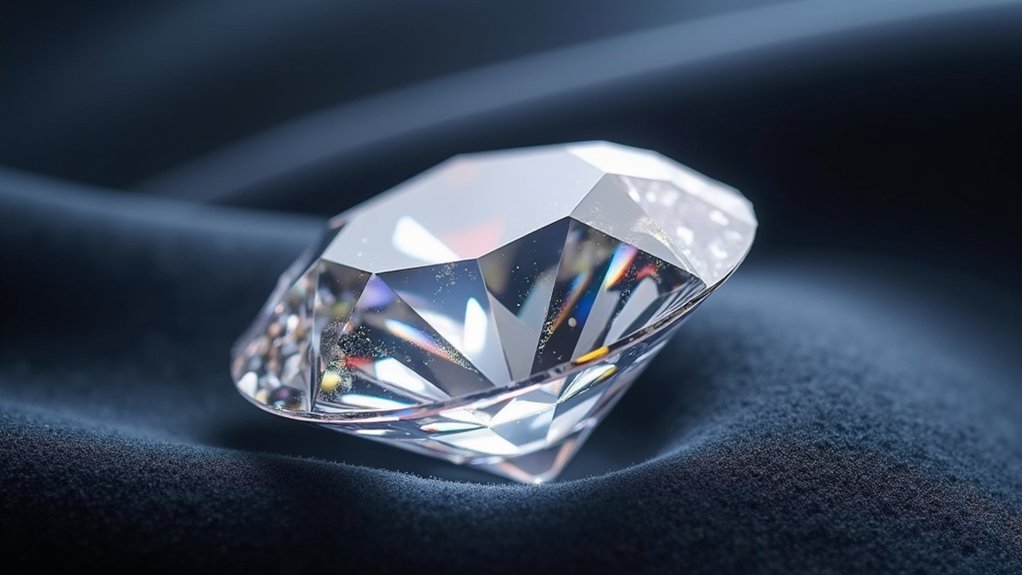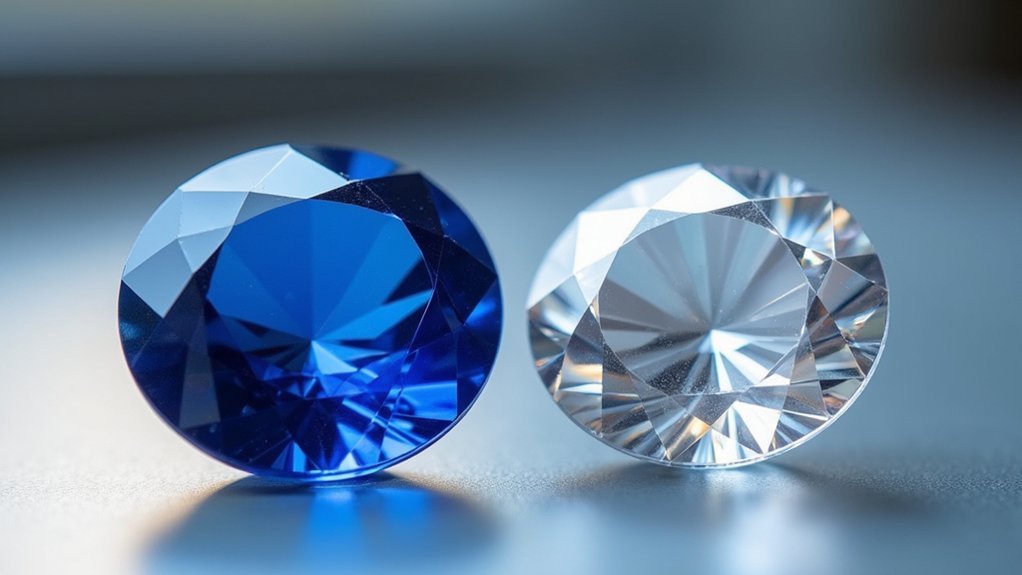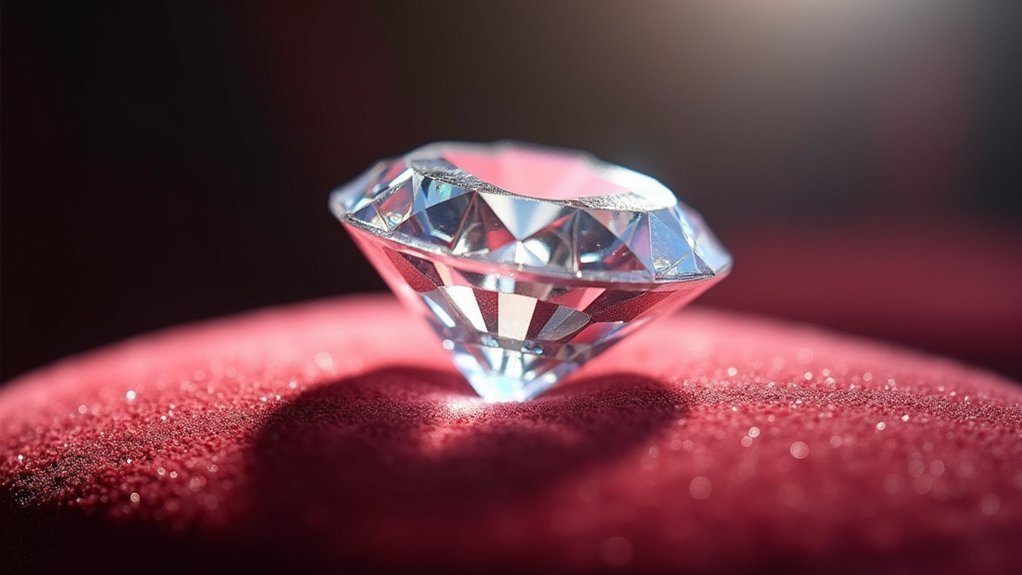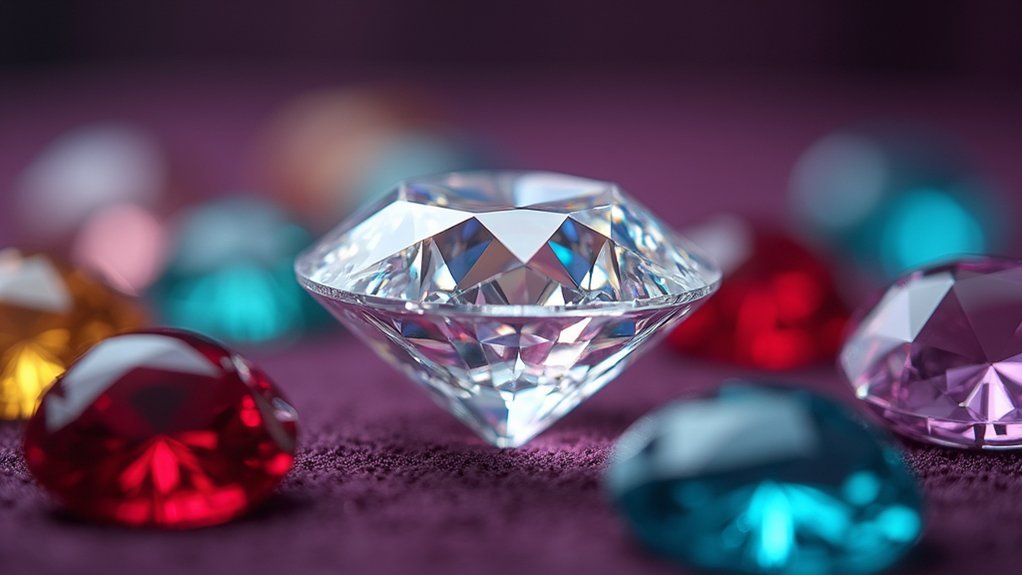Clarity grading matters because it reveals how internal inclusions affect your gem’s sparkle and value. Higher clarity grades (VVS, VS) mean fewer imperfections, allowing light to travel freely and creating maximum brilliance. While flawless stones command premium prices, “eye-clean” diamonds like VS2 and SI1 offer excellent value without visible flaws. The positioning and size of inclusions impact performance more than their mere presence. Understanding clarity helps you make smarter investment decisions.
Why Clarity Grading Matters For Brilliant Gems?

While most gem enthusiasts focus on color and cut, clarity grading stands as a fundamental pillar in determining a gemstone’s true value and beauty. When you’re purchasing a diamond, understanding the Gemological Institute of America’s clarity scale gives you essential insight into what you’re buying.
Clarity grading evaluates both internal inclusions and external blemishes that affect how light travels through your gem. Higher clarity grades like VVS and VS typically display more brilliance and fire, making them particularly desirable for fine jewelry.
A diamond’s brilliance relies heavily on clarity—fewer inclusions mean more spectacular light performance and enhanced beauty.
This doesn’t mean lower-graded stones can’t be beautiful—they often provide excellent value while remaining visually appealing.
The clarity scale ranges from Flawless to Included, giving you a standardized way to compare diamonds and make informed decisions that balance your aesthetic preferences with your budget.
The Science Behind Clarity Assessment
Although gemstones captivate with their sparkle, the science of clarity evaluation reveals why some diamonds shine brighter than others. Since 1953, the GIA clarity scale has provided jewelers and consumers with a standardized method for evaluating a diamond’s quality, from Flawless (FL) to Included (I3).
When examining diamonds through a standard jeweler’s loupe at 10x magnification, experts evaluate:
- Size, nature, and number of inclusions and blemishes
- Location of imperfections within the stone
- Relief (how visible the inclusions are against the diamond)
The diamond clarity grade greatly affects both visual appeal and value.
While perfect clarity commands premium prices, eye-clean diamonds often provide the best value—typically VS2 or higher—appearing flawless to the naked eye while costing considerably less than their technically perfect counterparts.
Decoding the GIA Clarity Scale

The GIA Clarity Scale stands as the jewelry industry’s gold standard for evaluating diamond quality. When you’re selecting your perfect diamond, understanding this diamond grading system helps you make an informed decision that balances beauty with value for money.
| Clarity Grade | Description | Appearance |
|---|---|---|
| Flawless (FL) | No inclusions or blemishes | Perfectly clear |
| Very Slightly Included (VS) | Minor inclusions | Typically eye clean |
| Included (I1-I3) | Noticeable imperfections | Clarity greatly affects appearance |
The scale categorizes diamonds across eleven levels within six main categories, from the rare Flawless specimens (less than 1% of all diamonds) to those with visible inclusions. A diamond’s quality isn’t solely determined by absence of flaws—the number, size, position, and relief of inclusions all influence its final clarity grade and value.
Common Inclusions and Their Impact on Brilliance
Every diamond tells a story through its inclusions—natural characteristics that form within the gem during its creation deep beneath the earth’s surface.
When you’re selecting a gemstone, understanding how these internal imperfections affect its brilliance is essential to making an informed purchase.
Common inclusions like clouds, feathers, and crystals can obstruct light, directly impacting your diamond’s appearance and visual appeal.
The clarity of a diamond isn’t just about aesthetics—it fundamentally determines how light performs within the stone.
- Larger or more numerous inclusions reduce a gem’s sparkle by interrupting light flow
- Inclusions positioned near the surface affect brilliance more than deeper ones
- Higher clarity grades typically translate to greater brilliance and value of gemstones
Eye-Clean vs. Technically Flawless: What Matters Most

When shopping for diamonds, you’ll often face an important choice: should you prioritize technical perfection or visual beauty?
While the GIA clarity scale ranges from Flawless (FL) to heavily Included (I3), what matters most is how the gem appears to your naked eye.
Eye-clean diamonds—often found in the VS2 and SI1 range—offer exceptional value compared to technically flawless stones.
These diamonds appear inclusion-free without magnification, maintaining their visual appeal while costing considerably less.
The clarity grading considers multiple factors including size, location, and nature of inclusions, but their impact on aesthetic appeal varies greatly.
How Clarity Affects Light Performance and Sparkle
Beyond visual appeal, clarity plays a fundamental role in how your diamond interacts with light. When you choose higher clarity grades on the GIA clarity scale (FL, IF, VVS1), you’re investing in superior light performance.
Inclusions act as obstacles, blocking light’s path through the gem and diminishing its natural brilliance.
Eye-clean diamonds (typically VS2 and above) deliver considerably better sparkle because:
- They allow unobstructed light entry and exit through the diamond
- They maximize scintillation—the flashes of light you see as the diamond moves
- They enhance overall visual appeal with fewer internal distractions
A well-cut diamond with excellent clarity creates a magnificent display of fire and brilliance.
You’ll notice the difference in how light dances through clearer stones, creating that coveted enchanting sparkle.
Clarity Considerations for Different Gemstone Types

Unlike diamonds with their stringent clarity standards, different gemstone varieties follow unique clarity expectations based on their geological formation and inherent characteristics.
Gemologists evaluate clarity characteristics according to type classifications—Type 1 gems like diamonds demand higher purity, where even minor visible inclusions markedly impact value.
The GIA clarity scales range from Flawless diamonds to heavily Included specimens (I1-I3).
Tools and Techniques for Professional Clarity Grading
Professional gemologists rely on specialized equipment and standardized methodologies to accurately assess a gemstone’s clarity. When you’re seeking clarity grading for your precious stones, experts typically use a jeweler’s loupe or microscope at 10x magnification to identify inclusions and blemishes.
The Gemological Institute of America (GIA) clarity scale provides the industry standard, ranging from Flawless to I3.
– Graders evaluate five critical factors: size, nature, number, location, and relief of inclusions
Digital imaging and AI technology now complement traditional methods, enhancing accuracy.
Certification reports document your gem’s clarity grade, giving you confidence in your purchase.
Advanced tools continue to revolutionize grading diamonds and other gemstones, ensuring you receive the most precise assessment of your gem’s true quality and value.
Making Value-Based Decisions When Selecting Clarity Grade

When shopping for diamonds, how do you balance beauty and budget? Understanding clarity grading empowers you to make informed value-based decisions.
Buying diamonds requires navigating between dazzling appearance and financial wisdom—clarity knowledge is your compass.
While higher clarity grades like FL command premium prices due to their rarity, you don’t need a flawless stone to achieve beauty.
Consider diamonds graded VS2 or higher on the GIA clarity scale for an eye-clean appearance without the steep investment. For larger stones, a cost-effective choice might be selecting SI1 diamonds, where visible inclusions often disappear once mounted.
Your personal preferences should guide your selection—balance aesthetic desires with financial considerations.
Frequently Asked Questions
Does Clarity Really Matter in a Diamond?
Yes, clarity matters as it affects your diamond’s sparkle. If you’re seeking eye-clean beauty, you don’t need flawless grades. VS2-SI1 diamonds offer great value while still appearing perfect to your naked eye.
Is Color or Clarity More Important in a Radiant Diamond?
In a radiant diamond, clarity typically matters more than color. You’ll see better brilliance with higher clarity since it affects sparkle directly. However, you should balance both based on your personal preferences.
Does Clarity Make a Diamond Sparkle More?
Yes, clarity impacts your diamond’s sparkle. When there are fewer inclusions, more light passes through, enhancing brilliance. However, cut quality plays an even bigger role in maximizing sparkle than clarity alone does.
Does Clarity Matter for Lab Grown Diamonds?
Yes, clarity absolutely matters for your lab-grown diamond. You’ll find they’re graded on the same GIA scale as natural diamonds, affecting both appearance and price. Higher clarity means fewer visible imperfections in your gem.
In Summary
You’ll find that clarity grading isn’t just about technical perfection—it’s about finding the sweet spot between quality and value. By understanding how inclusions affect light performance, you can make smarter purchases that maximize brilliance without overpaying. Remember, the best clarity grade is one that meets your visual expectations while respecting your budget. Trust your eyes alongside the certification when making your final decision.





Leave a Reply